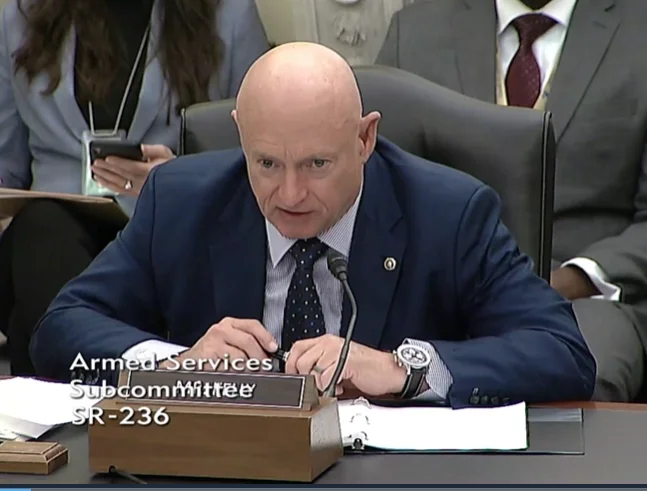Senator Mark Kelly | wikipedia
Senator Mark Kelly | wikipedia
In case you missed it, this week, Arizona Senator Mark Kelly, a Navy combat veteran, chaired his first Senate Armed Services Airland Subcommittee hearing to examine the U.S. Army’s modernization efforts as Congress begins work on the annual defense bill.
During the hearing, Sen. Kelly highlighted the Army’s plans to balance investment in newer modernization priorities while supporting existing programs in the face of Russia’s war in Ukraine and increasing aggression from China. Sen. Kelly also highlighted the important role that Fort Huachuca and the Yuma Proving Ground in Arizona will play in enhancing the Army’s testing capabilities, which in turn drive modernization efforts.
“As you all know, China has been investing heavily in its military and in emerging technologies. The best way to deter them is not just to keep pace on the cutting edge, but also to continue modernizing our forces to make clear to our adversaries that they cannot beat us on the battlefield,” said Kelly during his opening remarks. “At the same time, Russia continues to demonstrate an aggressive posture. And operations in Europe remind us that enduring systems require modernization investments too.”

Sen. Kelly: General, I want to move on to a little bit of a different topic here, which is testing critical capabilities. And General Rainey, I’m concerned that our ability to test certain capabilities, ranging from things like electronic warfare to directed energy to hypersonics are constrained by some current limitations that we have to conduct open air as well as hardware, in the loop, and simulated tests, environments and experimentation, but also real world testing. I come from a flight test background for a number of years. We have some facilities around the country. Some really good ones happen to be in Arizona. The Electronic Proving Ground at Fort Huachuca, the Yuma Proving Ground. I think both of these facilities are crucial to the Army’s efforts. General Rainey, can you explain how the Army is ensuring that it has sufficient capacity and capability to proceed on its modernization requirements at the pace that our national defense strategy demands? General Rainey: Thank you, Senator. To just acknowledge the point: the ability to test is absolutely critical. We currently are not. That’s not the pacing item. We currently aren’t waiting for the ability to test on any modernization efforts. But as we continue to make progress, we’ve identified that as a potential, and that’s why we are continuing to invest heavily in places like Yuma and Fort Huachuca and Camp Grayling and other places. So what we can’t afford to do, from the modernization and transformation standpoint, would be to continue to pay for test capability and pay for training capability as separate things. One of the very positive initiatives the Army has is to bring those test and training capabilities together so to make sure we don’t ask for resources, use it in a test, and then let it go to waste. We need to use it for tests and then be able to train. And that’s why a place like the Fox Training Complex [at Fort Huachuca], that gives you the ability to both test effectively and train effectively, is one of our priorities. Sen. Kelly: […] I think Fort Huachuca, especially when we look at issues we have that we’re facing with electronic warfare, and it offers a very unique geography, let’s say, to be able to transmit at relatively high power level without disrupting populations […] But I agree with you that the more we can integrate those two facilities into one, it would certainly make sense to me. In the in the Navy and the Air Force we traditionally haven’t done that. So maybe more recently we have. But like the Pax River [Naval Air Station Patuxent River] Naval Air Station is really about developmental tests. At Edwards Air Force Base, the same for the Air Force. So it’s good to see the Army is doing this. Beyond that, how do you leverage the full capacity of an installation? I have found as I’ve traveled down to Fort Huachuca and down to Yuma Proving Ground they often have the range. What they tend to be missing is like an investment in the test infrastructure. It might be theodolites, it might be other equipment to gather data. And I think we often under invest in those systems. Is that your sense, General? General Rainey: On the specifics of our investment in that, I’ll defer to the Honorable Bush. But to your point about how do you optimize them—another thing is using all the tools you have so live virtual and constructed and having the ability to link those capabilities. So linking someplace like Yuma to the National Training Center to Camp Pendleton, which is something that we do during Project Convergence and need to continue to do that to find efficiencies. To your point about the joint, we need to not just be able to do that in the Army, but we need to be able to train together, experiment together as a joint force. And that’s one of the main efforts of the persistent experimentation we have in Project Convergence. You’ll see a lot of that, hopefully if you can come visit us at Edge when we do the biggest annual aviation experiment we do out of Yuma next month.
Original source can be found here.






 Alerts Sign-up
Alerts Sign-up